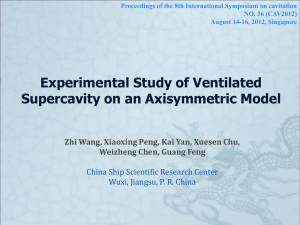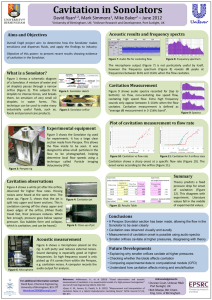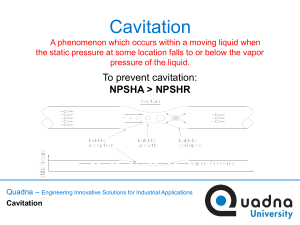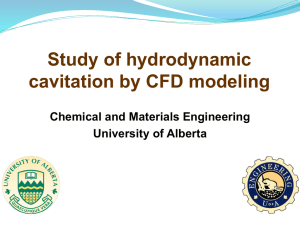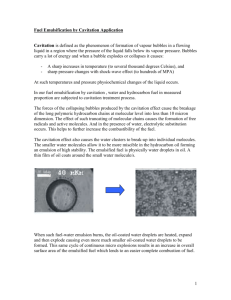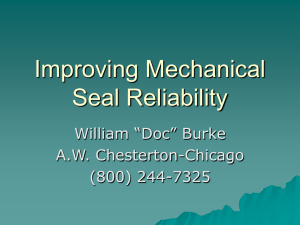armstronggrantSNPv6 mdvcomments - The Patek Lab
advertisement
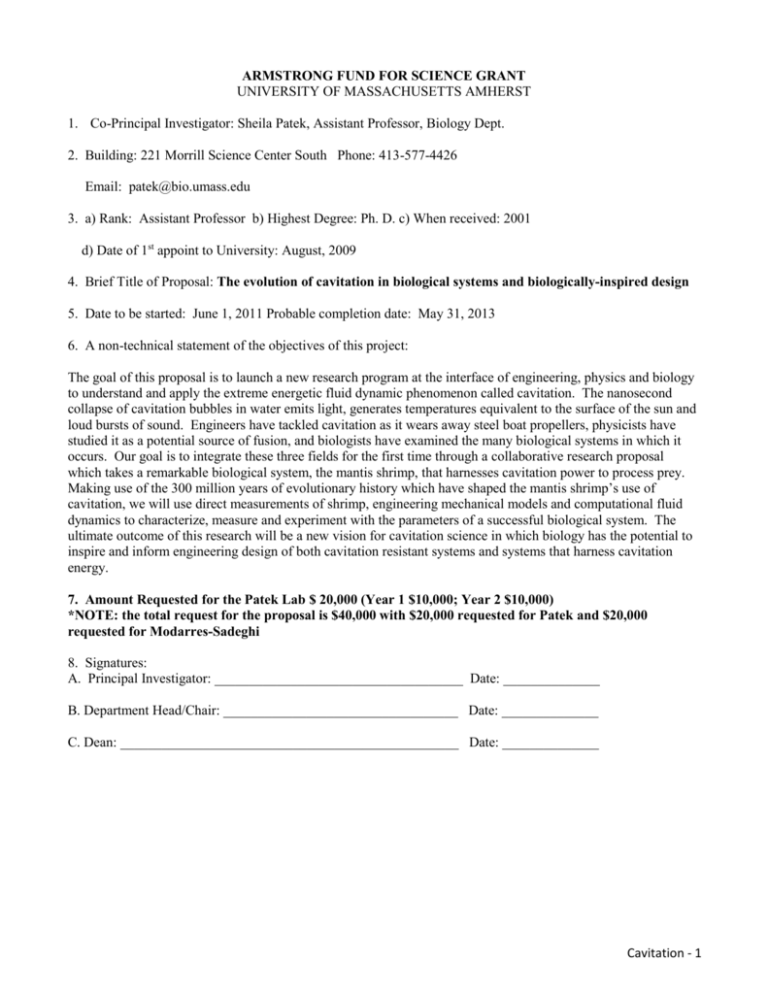
ARMSTRONG FUND FOR SCIENCE GRANT UNIVERSITY OF MASSACHUSETTS AMHERST 1. Co-Principal Investigator: Sheila Patek, Assistant Professor, Biology Dept. 2. Building: 221 Morrill Science Center South Phone: 413-577-4426 Email: patek@bio.umass.edu 3. a) Rank: Assistant Professor b) Highest Degree: Ph. D. c) When received: 2001 d) Date of 1st appoint to University: August, 2009 4. Brief Title of Proposal: The evolution of cavitation in biological systems and biologically-inspired design 5. Date to be started: June 1, 2011 Probable completion date: May 31, 2013 6. A non-technical statement of the objectives of this project: The goal of this proposal is to launch a new research program at the interface of engineering, physics and biology to understand and apply the extreme energetic fluid dynamic phenomenon called cavitation. The nanosecond collapse of cavitation bubbles in water emits light, generates temperatures equivalent to the surface of the sun and loud bursts of sound. Engineers have tackled cavitation as it wears away steel boat propellers, physicists have studied it as a potential source of fusion, and biologists have examined the many biological systems in which it occurs. Our goal is to integrate these three fields for the first time through a collaborative research proposal which takes a remarkable biological system, the mantis shrimp, that harnesses cavitation power to process prey. Making use of the 300 million years of evolutionary history which have shaped the mantis shrimp’s use of cavitation, we will use direct measurements of shrimp, engineering mechanical models and computational fluid dynamics to characterize, measure and experiment with the parameters of a successful biological system. The ultimate outcome of this research will be a new vision for cavitation science in which biology has the potential to inspire and inform engineering design of both cavitation resistant systems and systems that harness cavitation energy. 7. Amount Requested for the Patek Lab $ 20,000 (Year 1 $10,000; Year 2 $10,000) *NOTE: the total request for the proposal is $40,000 with $20,000 requested for Patek and $20,000 requested for Modarres-Sadeghi 8. Signatures: A. Principal Investigator: ____________________________________ Date: ______________ B. Department Head/Chair: __________________________________ Date: ______________ C. Dean: _________________________________________________ Date: ______________ Cavitation - 1 ARMSTRONG FUND FOR SCIENCE GRANT UNIVERSITY OF MASSACHUSETTS AMHERST 1. Co-Principal Investigator: Yahya Modarres-Sadeghi Dept: Mechanical and Industrial Eng. 2. Building:Gunness 10B Phone: 413-545-2468 Email: modarres@ecs.umass.edu 3. a) Rank: Assistant Professor b) Highest Degree: PhD c) When received: 2006 d) Date of 1st appoint to University: September 2009 4. Brief Title of Proposal: The evolution of cavitation in biological systems and biologically-inspired design 5. Date to be started: June 1, 2011 Probable completion date: May 31, 2013 6. A non-technical statement of the objectives of this project: 7. Amount Requested for Modarres-Sadeghi lab $ 20,000 (Year 1 $ 10,000; Year 2 $ 10,000) *NOTE: the total request for the proposal is $40,000 with $20,000 requested for Patek and $20,000 requested for Modarres-Sadeghi 8. Signatures: A. Principal Investigator: ____________________________________ Date: ______________ B. Department Head/Chair: __________________________________ Date: ______________ C. Dean: _________________________________________________ Date: ______________ Cavitation - 2 ARMSTRONG FUND FOR SCIENCE GRANT UNIVERSITY OF MASSACHUSETTS AMHERST 1. Co-Principal Investigator: David P. Schmidt Dept: Mechanical and Industrial Eng. 2. Building: Marston 210B Phone: (413) 545-1393 Email: schmidt@ecs.umass.edu 3. a) Rank: Associate Professor b) Highest Degree: Ph.D. c) When received: 1997 d) Date of 1st appoint to University: 2000 4. Brief Title of Proposal: The evolution of cavitation in biological systems and biologically-inspired design 5. Date to be started: June 1, 2011 Probable completion date: May 31, 2013 6. A non-technical statement of the objectives of this project: 7. Total AFS Amount Requested $ _____0______ (Year 1 $ ____0_____; Year 2 $ _____0_) 8. Signatures: A. Principal Investigator: ____________________________________ Date: ______________ B. Department Head/Chair: __________________________________ Date: ______________ C. Dean: _________________________________________________ Date: ______________ Cavitation - 3 The evolution of cavitation in biological systems and biologically-inspired design Cavitation is a ubiquitous, extremely energetically intense phenomenon which concerns nearly every branch of science and engineering that deals with liquids at low pressure. Under very low pressures, molecules are literally pulled away from each other to form a vapor bubble that collapses in a nanosecond implosion. This implosion occurs with such intense energy that it emits light, sound, and heat equivalent to the surface of the sun (Brennen, 1995). Cavitation science has run in three parallel tracks for the past century. Engineers model and try to avoid cavitation damage in engineered systems, physicists attempt to control cavitation and characterize energetics (Brennen, 1995), and biologists observe its occurrence in systems ranging from desiccating plants and exploding fungi to newly breathing insects and fast-moving aquatic animals (Milburn, 1970; Patek and Caldwell, 2005; Patek et al., 2004; Perks et al., 2004; Ritman and Milburn, 1990; Woods et al., 2009). Yet, beyond an occasional study that attempts to characterize (or solve?) the basic math of biological cavitation (Lohse et al., 2001; Smith, 1991; Versluis et al., 2000), these scientific and engineering worlds have remained separate, in spite of the substantial ongoing research and interest in cavitation across all of these fields. Most notably, to our knowledge, no attempts have been made to learn about the evolution of biological cavitation design and apply it to human-engineered systems. Thus, our goal is to bring three UMass laboratories together to build an entirely new research program at the interface of biological evolution and engineering design. We will ground this study on the physics, engineering and biology of cavitation control and avoidance in mantis shrimp (Stomatopoda). The century of engineering and physics research on cavitation is dwarfed by the hundreds of millions of years over which biological systems have been tackling cavitation costs and energetic potential. Given, that biological systems have had the opportunity to respond to natural selection over very long timescales to deal with energetically extreme phenomena, humans have the unique opportunity to understand the resulting design of cavitation-generating devices and cavitation-resistant devices in biology by studying the natural experiments performed over evolutionary history. We propose to launch a new research program examining the evolution of cavitating systems in biology and their potential for inspiring and informing engineering design of cavitating systems. This research has two primary goals: (1) To quantitatively characterize the biological response over evolutionary history to cavitation, specifically testing how cavitation can be wielded constructively and also how self-structural damage caused by cavitation bubble collapse can be avoided. (2) To synthesize the evolutionary biological design principles of cavitation, both from fluid dynamic and material perspectives, toward the goal of informing the design of human-engineered devices to both use cavitation energetics and minimize cavitation damage. Present on the planet for approximately 300 million years with over 500 fossil and extant species, mantis shrimp have extremely fast-rotating appendages that they use to hammer or spear prey. When hammering, the peacock mantis shrimp’s appendages move at peak speeds of 20 m/s such that when they strike their hard-shelled prey, a cavitation bubble is formed between their appendage and the prey’s surface (Patek et al., 2004) (Fig. 1). The result is that mantis shrimp generate two extremely high and brief force-peaks each time an appendage strikes the prey; the first peak is due to the impact of the appendage and the second is due to the implosion of the cavitation bubble (Patek and Caldwell, 2005) (Fig. 2). This Figure·1. The cigar-sized Peacock mantis shrimp use a pair of large raptorial appendages (top, white arrow) to strike hard objects with such high speeds that cavitation bubbles form between the appendage and striking surface. In a series of high speed video images (5000 frames per second), the dactyl heel of the raptorial appendage strikes a snail that is loosely wired to a stick. Images recorded at 0.2·ms intervals. Cavitation (yellow arrow) is visible between the dactyl heel and snail (D–G). Cavitation - 4 research is the first to measure and characterize the forces of cavitation bubble collapse in a biological prey capture system, and biologists and engineers have become increasingly interested in the ability of this biological system to resist cavitation damage and to use it effectively for processing prey. The Patek lab focuses on the biomechanics of extremely rapid prey capture events and has developed techniques such as piezoelectronic impact sensors to measure impact and cavitation forces, extreme high speed video to visualize rapid movements, materials testing for characterization of elastic materials, Computed Tomography (CT) scanning to build 3-D computer models for finite element analysis, and acoustic analyses to quantitatively detect cavitation. While these biomechanical Figure 2. Force generated when a mantis shrimp approaches have yielded a strong descriptive? foundation for understanding the biology and evolution of fast movements, the strikes with both raptorial appendages. Based on the high-speed video and acoustic analyses, the two quantitative and computational modeling of these fast higher peak forces were generated by limb impact movements have remained beyond the skillset of the biologists and the two lower peaks were generated during who populate the Patek laboratory. Through a spontaneous cavitation bubble collapse (Patek and Caldwell, interaction between Patek and Modarres-Sadeghi at one of 2005; Patek et al., 2004; Patek et al., 2007). Chancellor Holub’s junior faculty breakfasts last spring, the first window into a far more rigorous computational and modeling approach was opened. At the Fluid-Structure Interactions (FSI) Lab, Modarres-Sadeghi and his colleagues focus on bio-inspired fast-start mechanisms. For example, they have built a robotic fish which accelerates at 40 m/s2, in order to understand the basic mechanisms and scaling laws involved in such fast starts (Conte et al., 2010). The aim of this research is to establish a reverse-engineering methodology combining experimentation on a robotic device with lessons learned from evolutionary changes of live animals. The final goal is to create biologically-inspired designs of man-made vehicles with high efficiency in maneuvering. We will use the experience gained in building this fast-movement mechanism in designing and quantifying the experimental component of the proposed research. Emerging from this nascent collaboration, the first biologically-inspired, cavitating physical model was built this fall through the efforts of an engineering graduate student, Suzanne Cox, working in both the ModarresSadeghi and Patek labs. With this novel, biologically inspired model and a laboratory full of the real cavitating animals, a third member of the collaboration was needed – an engineer with the ability to computationally model cavitation. Remarkably, a third UMass professor was found – David Schmidt – who has designed and modeled cavitation devices in engineered systems (Schmidt and Corradini, 1997; Schmidt et al., 1997; Schmidt et al., 1999). With the team and place and thus poised to launch a new collaborative research program, we seek initial funding to collect enough preliminary data to justify a full grant application. Specifically, we will pursue funding through NSF’s Cyber-Enabled Discovery and Innovation (CDI) program and through ONR’s on-going support of cavitation research under its Broad Agency Announcements (Schmidt is a past winner of the Office of Naval Research Young Investigator Prize). We plan to work as a team to generate enough preliminary results that establishes credibility with our potential sponsors. Toward this goal, we plan to integrate biology and engineering analysis of cavitation through a three-pronged approach, integrating the biology of mantis shrimp, physical models of biologically-inspired cavitators, and mathematical models of cavitation using computational fluid dynamic technique. Beginning with the biological approach, cavitation and cavitation dynamics will be examined across a wide range of live mantis shrimp species. The remarkable diversity of mantis shrimp appendages and feeding strategies offers a rich array of kinematics and appendage shapes with which to observe the presence, absence and use of cavitation. Two in-depth studies have been completed in one cigar-sized mantis shrimp species that uses a hammer (Odontodactylus scyllarus) and a foot-long mantis shrimp species that uses an elongate spear to grab unsuspecting prey overhead (Lysiosquillina maculata). The Patek lab is continuing to collect, film and analyze strike mechanics across a wide range of species from which key information about the speed, acceleration, and the Cavitation - 5 presence and absence of cavitation bubbles can be examined. In addition, we have scanned a wide array of species using micro-CT, converted them into 3-D virtual appendages and have built physical models (rapid prototyping) and finite element models for dynamic testing. With the comparative kinematic, shape and mechanical data in hand from the actual biology, the second prong of the investigation can tackle the dynamics of cavitation in a controlled setting using the mechanical model of a mantis shrimp. By attaching a range of different shape appendages made of a variety of materials (e.g., plastics to metals) and running the tests across kinematic parameters both relevant to the biological systems and beyond the observed range in biology, the physical space of cavitation and impact dynamics can be characterized. This model approach is critical; it allows us to control for many aspects of appendage strikes, which otherwise would not be possible with the natural behavioral variability of live mantis shrimp, while also allowing for the use of completely accurate mantis shrimp appendage shapes made from models derived directly from the animals. The third prong of the investigation is to conduct an analysis of cavitation using a fully computational approach, called computational fluid dynamics (CFD). In this case, the appendage can be idealized in a wide range of shapes and moved through the fluid at variable speeds, thus? with CFD, it is possible to fully characterize the fluid dynamic flow and energetics of the appendage. This third level of analysis brings the collaboration full circle; it allows for a fully quantitative characterization of cavitation dynamics that can be directly applied to the design of cavitation resistant or cavitation enhancing devices. The culmination of this research will be a novel examination of the evolution of biological cavitation yielding information valuable to the fields of evolutionary biology, biomechanics, engineering mechanics and biologicallyinspired design. This last component is perhaps the closest link to the “anticipated application of outcomes” central to the Armstrong Fund’s mission. In addition to the key contributions to basic research, we will ultimately develop a quantitative space of shape and kinematics that allows the overlay of the biological evolutionary “space” of cavitation phenomena with the theoretical engineering “space”. This quantitative model space provides a mechanism to look at the overlap between evolutionarily possible/observed phenomena, engineering theoretical space and the actual space currently used by engineers in their designed systems. This analysis provides a quantitative window into the potential application of outcomes, such that we both build and design configurations that are not currently used in engineering systems and that could potentially optimize cavitation control or cavitation damage resistance not previously attempted in engineered systems. References Cited Brennen, C. E. (1995). Cavitation and bubble dynamics: Oxford University Press. Conte, J., Modarres-Sadeghi, Y., Watts, M. N., Hover, F. S. and Triantafyllou, M. S. (2010). A fast-starting robotic fish that accelerates at 40 m s-2 Journal of Bioinspiration and Biomimetics 5, 035004. Lohse, D., Schmitz, B. and Versluis, M. (2001). Snapping shrimp make flashing bubbles. Nature 413, 477-478. Milburn, J. A. (1970). Cavitation and osmotic potentials of Sordaria ascospores. New Phytologist 69, 133-141. Patek, S. N. and Caldwell, R. L. (2005). Extreme impact and cavitation forces of a biological hammer: strike forces of the peacock mantis shrimp (Odontodactylus scyllarus). Journal of Experimental Biology 208, 3655-3664. Patek, S. N., Korff, W. L. and Caldwell, R. L. (2004). Deadly strike mechanism of a mantis shrimp. Nature 428, 819-820. Patek, S. N., Nowroozi, B. N., Baio, J. E., Caldwell, R. L. and Summers, A. P. (2007). Linkage mechanics and power amplification of the mantis shrimp's strike. Journal of Experimental Biology 210, 3677 - 3688. Perks, M. P., Irvine, J. and Grace, J. (2004). Xylem acoustic signals from mature Pinus sylvestris during an extended drought. Annals Of Forest Science 61, 1-8. Ritman, K. T. and Milburn, J. A. (1990). The acoustic detection of cavitation in fern sporangia. Journal of Experimental Botany 41, 1157-1160. Schmidt, D. P. and Corradini, M. L. (1997). Analytical prediction of the exit flow of cavitating orifices. Atomization and Sprays 7, 603-616. Schmidt, D. P., Rutland, C. J. and Corradini, M. L. (1997). A numerical study of cavitating flow through various nozzle shapes. Transactions of the SAE. Schmidt, D. P., Rutland, J. and Corradini, M. L. (1999). A fully compresible model of small, high speed, cavitating nozzle flows. Atomization and Sprays 9, 255-276. Smith, A. M. (1991). Negative Pressure Generated By Octopus Suckers: A Study of the Tensile Strength of Water in Nature. Journal of Experimental Biology 157, 257-271. Versluis, M., Schmitz, B., von der Heydt, A. and Lohse, D. (2000). How snapping shrimp snap: through cavitating bubbles. Science 289, 2114-2117. Woods, H. A., Sprague, J. C. and Smith, J. N. (2009). Cavitation in the embryonic tracheal system of Manduca sexta. Journal of Experimental Biology 212, 3296-3304. Cavitation - 6 Cavitation - 7 S. N. PATEK Department of Biology Organismic and Evolutionary Biology Graduate Program University of Massachusetts, Amherst, MA 01003 USA Phone: (413) 577-4426 Email: patek@bio.umass.edu Website: www.bio.umass.edu/biology/pateklab PROFESSIONAL PREPARATION Harvard University, Cambridge, MA. Biology Duke University, Durham, NC. Biology Miller Institute, UC Berkeley Comparative biomechanics A.B. with Honors, 1994 Ph.D. 2001 2001-2004 APPOINTMENTS Assistant Professor, Department of Biology, University of Massachusetts Amherst. Radcliffe Fellow, Radcliffe Institute for Advanced Studies, Harvard University. Assistant Curator, University of California Museum of Paleontology, Berkeley, CA. Assistant Professor, Department of Integrative Biology, University of California Berkeley. Postdoctoral Fellow, Miller Institute for Basic Research in Science, University of California Berkeley. PUBLICATIONS Available at: http://www.bio.umass.edu/biology/pateklab/publications Five publications most closely related to the proposed project (* undergraduate-level co-author): Claverie, T., E. Chan* and S.N. Patek. 2010. Modularity and scaling in fast movements: power amplification in mantis shrimp. Evolution(published online). Zack*, T.I., T. Claverie, and S.N. Patek. 2009. Elastic energy storage in the mantis shrimp’s fast predatory strike. Journal of Experimental Biology 212: 4002-4009. Patek, S.N., B. N. Nowroozi*, J. E. Baio*, R. L. Caldwell and A. P. Summers. 2007. Linkage mechanics and power amplification of the mantis shrimp’s raptorial strike. Journal of Experimental Biology 210: 3677-3688. Patek, S.N. and R. L. Caldwell. 2005. Extreme impact and cavitation forces of a biological hammer: strike forces of the peacock mantis shrimp (Odontodactylusscyllarus). Journal of Experimental Biology 208: 3655-3664. Patek, S.N., W.L. Korff and R.L. Caldwell. 2004. Deadly strike mechanism of a mantis shrimp. Nature428:819820. Five other publications related to the proposed project: Patek, S.N., D. Dudek, M.V. Rosario*.Accepted pending minor revisions.From bouncy legs to poisoned arrows: elastic movements in invertebrates.Journal of Experimental Biology. Taylor, J.R.A. and S.N. Patek. 2010. Ritualized fighting and biological armor: the impact mechanics of the mantis shrimp’s telson. Journal of Experimental Biology.213: 3496-3504. Patek, S.N., J.E. Baio*, B. L. Fisher, and A. V. Suarez. 2006. Multifunctionality and mechanical origins: ballistic jaw propulsion in trap-jaw ants. Proceedings of the National Academy of Sciences 103(34): 12787-12792. Patek, S.N. and T.H. Oakley. 2003. Comparative tests of evolutionary tradeoffs in a palinurid lobster acoustic system. Evolution 57(9): 2082-2100. Patek, S.N. 2001. Spiny lobsters stick and slip to make sound. Nature 411: 153-154. 2009-present 2008-2009 2005-2009 2004-2009 2001-2004 AWARDS Radcliffe Fellowship for “scholars, scientists, artists, and writers of exceptional promise and demonstrated accomplishments“.Radcliffe Institute for Advanced Studies, Harvard University.2008-9 ($80,000). Christopher Clavius, S.J. Award “given to a researcher who also serves as an inspiration to others”. Sigma Xi, St. Joseph’s University. 2009. Bartholomew Award “for distinguished contributions to comparative physiology”.Society for Integrative and Comparative Biology. 2008. Hellman Award to junior faculty with “promise for distinction in their research” ($25,000). 2007. Cavitation - 8 Brilliant 10 Award, awarded annually to ten of the “most dynamic, promising young researchers at institutions around North America” by Popular Science magazine. 2004. Best Student Paper Award, Division of Invertebrate Zoology, Society for Integrative and Comparative Biology. 2000. Best Student Paper Award, The Crustacean Society. 2000. Philanthropic Education Organization Scholar Award ($7000).1999-2000. GRANTS AND FELLOWSHIPS National Science Foundation IOB ($330,000).2007-2010. Research Initiative Seed Grant – Beckman Institute for Advanced Science and Technology.2005-7. Junior Faculty Research Grants, University of California Berkeley (net $24,254). 2004-6. Miller Postdoctoral Fellowship, University of California Berkeley ($180,000).2001-2004. National Science Foundation Dissertation Improvement Grant ($9812).1999-2000. National Science Foundation Graduate Research Fellowship.1996-2000. Seven grants under $5000. 1997-1999. SYNERGISTIC ACTIVITIES (1) Innovations in teaching and training: Introductory Biology (co-developed a new honors physics- and mathbased lecture and lab course), Invertebrate Zoology (co-developed a new lab, lecture, and field research course), research seminars in: Phylogeny-based methods in biomechanics and behavior, Biomechanics, Animal Behavior, UC Berkeley Presidential Chair Fellow for undergraduate education (program designed to develop novel undergraduate teaching methods). (2) Broadening participation at the university level: Advisory board for the Biology Scholars Program, Biology Fellows Program, and Biology Transfer Consortium (UC Berkeley programs designed to train and encourage minorities and economically disadvantaged students), co-founder and primary faculty member for a “Women in Science” graduate student group (UC Berkeley) that addresses strategies for success in the sciences, panels to discuss the role of Women in Science (including a recent panel at MIT), mentored 25+ undergraduate research projects, including a majority of women, and students from diverse backgrounds (e.g., Hispanic, Native American, African American, Filipino) with multiple students receiving prestigious McNair fellowships. (3) Broadening participation at the community level: Numerous public outreach lectures including a TED Talk (38,000 views on YouTube) and a New York Public Library “NYPL LIVE” live/broadcast lecture, many museum exhibits and public education websites (e.g., National Museum of Natural History, Morehead Planetarium, Science Museum of Minnesota, London Science Museum). (4) Broadening participation at the international level: More than 20 TV and radio programs, hundreds of print and web-based articles (e.g., BBC TV, Animal Planet, History Channel, National Geographic, BBC, CBC, NPR, Living on Earth, AAAS, New York Times, USA Today, Natural History Magazine, Science News, Discover Magazine [“best of the year” science story], Washington Post, San Francisco Chronicle, Nature, Science). (5) Service to the scientific community outside of the individual’s immediate organization: NSF review panel member (2002), Associate Editor for Functional Ecology (8/2010-2013), Chair of the Society for Integrative and Comparative Biology Student Support Committee (2009-2012), Steering Committee for the Five College Coastal and Marine Science Committee (2009-2012), reviewer for 29 journals and presses. COLLABORATORS & OTHER AFFILIATIONS Collaborators and co-editors: J. Baio (U. Washington), R. Caldwell (UC Berkeley), T. Claverie (UMass Amherst), M. S. deVries (UC Berkeley), R. Feldman (Kent State U.), B. Fischer (Cal. Acad. of Sciences), M. Fischer (St. Joseph U.), N. Money (Miami U.), B. Nowroozi (Brown U.), M. Porter (U. Maryland BC), A. Pringle (Harvard U.), L. E. Shipp (Scripps Inst. Oceanography), J. Spagna (William Paterson U.), E. Staaterman (U. of Miami), A. Suarez (U. Illinois Champagne-Urbana), A. Summers (U. Washington), B. Swanson (Gonzaga U.), J. Taylor (UC Berkeley), D. Tshudy (Edinboro U.), N. Tsutsui (UC Irvine), T. I. Zack (Harvard U.). Cavitation - 9 Biographical Sketch of Yahya Modarres-Sadeghi Department of Mechanical and Industrial Engineering University of Massachusetts, Amherst, MA 01003 http://mielsvr1.ecs.umass.edu/fsi/ Education 2006 2001 1998 Ph.D. of Mechanical Engineering, McGill University, Montreal, Canada Master’s of Mechanical Engineering, University of Tehran, Tehran, Iran Bachelor’s of Mechanical Engineering, Sharif University of Technology, Tehran, Iran Employment History 2009-present 2006-2009 2007-2009 2002-2006 Assistant Professor, Department of Mechanical and Industrial Engineering, University of Massachusetts,Amherst, MA, USA Postdoctoral Associate, Department of Mechanical Engineering. Massachusetts Institute of Technology (MIT), Cambridge, MA, USA Instructor, Department of Mechanical Engineering, Massachusetts Institute of Technology (MIT), Department of Mechanical Engineering, Northeastern University, Department of Physics, University of Massachusetts at Boston Research Assistant, Fluid-Structure Interactions Research Group McGill University, Montreal, Canada Publications Most closely related to the proposed project 1. J. Conte, Y. Modarres-Sadeghi, M.N. Watts, F.S. Hover, M.S. Triantafyllou (2010). A Fast-Starting Robotic Fish that Accelerates at 40 ms-2. Bioinspiration and Biomimetics5 035004. 2. Y. Modarres-Sadeghi, M.P. Païdoussis (2009). Nonlinear dynamics of extensible fluid conveying pipes, supported at both ends. Journal of Fluids and Structures, 25, 535-543. 3. Y. Modarres-Sadeghi, M.P. Païdoussis, C. Semler, E. Grinevich (2008). Experiments on Vertical Slender Flexible Cylinders Clamped at Both Ends and Subjected to Axial Flow.Philosophical Transactions of the Royal Society A, 366, 1275–1296. 4. Y. Modarres-Sadeghi, C. Semler, M. Wadham-Gagnon, M.P. Païdoussis (2007). Dynamics of Cantilevered Pipes Conveying Fluid. Part 3: Three-Dimensional Dynamics in the Presence of anEndMass. Journal of Fluids and Structures, 23, 589-603. 5. E. de Langre, M.P. Païdoussis, O. Doaré, Y. Modarres-Sadeghi (2007). Flutter of Long Cantilevered Cylinders in Axial Flow, Journal of Fluid Mechanics, 571, 371 – 389. Other significant publications 1. Y. Modarres-Sadeghi, F. Chasparis, M.S. Triantafyllou, M. Tognarelli, P. Beynet (2011). Chaotic Response is a Generic Feature of Vortex Induced Vibrations of Flexible Risers. Journal of Sound and Vibration. doi:10.1016/j.jsv.2010.12.007. 2. Y. Modarres-Sadeghi, H. Mukundan, J.M. Dahl, F.S. Hover, M.S. Triantafyllou (2010). The Effect of Higher Harmonic Forces on Fatigue Life of Marine Risers. Journal of Sound and Vibration, 329, 43-55. 3. H. Mukundan, Y. Modarres-Sadeghi, J.M. Dahl, F.S. Hover, M.S. Triantafyllou (2009). Monitoring Fatigue Damage on Marine Risers. Journal of Fluids and Structures, 25, 617-628. 4. Y. Modarres-Sadeghi, M.P. Païdoussis, C. Semler (2008). Three Dimensional Oscillations of aCantilever Pipe Conveying Fluid. International Journal of Non-linear Mechanics, 43, 18-25. 5. Y. Modarres-Sadeghi, M.P. Païdoussis, C. Semler (2005). A Nonlinear Model for an Extensible Slender Flexible Cylinder Subjected to Axial Flow. Journal of Fluids and Structures, 21, 609-627,Addendum 22, 597. Cavitation - 10 Synergistic Activities The PI was involved in developing online course materials for Dynamics and Control I in Fall 2007for Open Course Ware (Sanjay Sarma, Nicholas Makris, Yahya Modarres-Sadeghi, and Peter So,course materials for 2.003J/1.053JDynamics and Control I, Fall 2007. MIT OpenCourseWare(http://ocw.mit.edu), Massachusetts Institute of Technology). The PI has organized a one-day workshop on Fluid-Structure Interaction with the aim of bringing together wellknown researchers and students (undergraduate and graduate), in order to provide the opportunity for students to be in contact with the researches and get a better feeling of research. The PI has started building a Fluid-Structure Interaction lab at University of Massachusetts, Amherst, which will be used both for research activities similar to what is discussed in the proposed study here, and for educational goals for undergraduate and graduate courses. He is developing a course on FSI, in which students will use the facilities in the FSI lab in order to conduct experiments which help them understand the fundamentals of FluidStructure Interactions. Collaborators Michael S. Triantafyllou, Mechanical Engineering, MIT Michael P. Païdoussis. Mechanical Engineering, McGill University, Canada (PhD Advisor) Robert Blake, Zoology, University of British Columbia, Canada Luca Caracoglia, Civil and Environmental Engineering, Northeastern University Other Affiliations Research Affiliate at the Department of Mechanical Engineering of Massachusetts Institute of Technology (MIT) The PI has also worked as a Reviewer for the following journals: The Journal of Fluid Mechanics Journal of Fluids and Structures Sound and Vibration Proceedings of the Royal Society A Computers and Structures Journal of Marine Science and Technology International Journal of Heat and Fluid Flow Mechanics Research Communications Theoretical and Computational Fluid Dynamics ASME Journal of Vibration and Acoustics Cavitation - 11 DAVID P. SCHMIDT Mechanical and Industrial Engineering University of Massachusetts-Amherst Experience University of Massachusetts, Amherst Associate Professor (as of 9/06), Graduate Program Director (as of 7/09) Massachusetts Institute of Technology, Sloan Automotive Lab Visiting Scientist Co-founder of Convergent Thinking, LLC consulting firm Owner University of Wisconsin, Madison Research Assistant, Lecturer, Post-doctoral researcher Education Ph.D. Mechanical Engineering at the University of Wisconsin, Madison Minor in Nuclear Engineering, advised by M. Corradini M.S. Mechanical Engineering at Stanford University Advised by C. Kruger B.S. Mechanical Engineering at North Carolina State University 9/00-present 1/99-8/00 12/97-11/03 8/93-12/98 1997 1993 1992 Fellowships, Awards, and Honors Ralph Teetor Educational Award, given by SAE International, 2009 Fellowship to the Institute of Advanced Study, University of Bologna, 2006 Best Paper in Conference, ASME Internal Combustion Engine Div., 2003 College of Engineering Commencement Speaker, 2003. Student-selected MIE Professor of the Year, 2003. Student-selected MIE Advisor of the Year, 2003 Office of Naval Research Young Investigator Award, 2002. Semester Tuition Award from Chevron, University of Wisconsin, 1994. Myers-Uyhara Scholarship, University of Wisconsin, 1993. Departmental Research Fellowship, Stanford University, 1993. Graduated Magna Cum Laude, NCSU, 1992. John T. Caldwell Alumni Scholarship, NCSU, 1988-1992 Five Most Relevant Publications (of 37 journal & 42 conf. papers) Shaoping Quan, David Schmidt, Jinsong Hua, Jing Lou, “A numerical study of the relaxation and breakup of an elongated drop in a viscous liquid,” Journal of Fluid Mechanics, 640, 237 - 266, 2009.. Shaoping Quan , Jing Lou, David P. Schmidt, “Modeling Merging and Breakup in the Moving Mesh Interface Tracking Method for Multiphase Flow Simulations,” Journal of Computational Physics, 228(7), 2009. Shaoping Quan and David Schmidt, "A moving mesh interface tracking method for 3D incompressible two-phase flows," Journal of Computational Physics, 221(2), 2007. J. Murphy, D. Schmidt, S. P. Wang, and Michael L. Corradini, “Multi-Dimensional Modeling of Multiphase Flow Physics: High-Speed Nozzle and Jet Flows—A Case Study,” Nuclear Engineering and Design, 204, pp. 177190, 2001. David P. Schmidt, C. J. Rutland, and M. L. Corradini, “A Fully Compressible Two-Dimensional Model of High Speed Cavitating Nozzles,” Atomization and Sprays, 9, 1999. Cavitation - 12 Five Other Publications D. P. Schmidt, S. Gopalakrishnan, H. Jasak, “Multidimensional Simulation of Thermal Non-Equilibrium Channel Flow,” Intl. J. of Multiphase Flow, 36, 284-292, 2010. J. Lee, R. Madabhushi, C. Fotache, S. Gopalakrishnan, , and D. Schmidt, “Flashing Flow of Superheated Jet Fuel,” Proceedings of the Combustion Institute, 32(2), 2009.. S. Gopalakrishnan and David P. Schmidt, “A Computational Study of Flashing Flow in Fuel Injector Nozzles,” SAE Int. J. Engines 1(1), 160-170, 2008. Matthew J. Frain, David P. Schmidt, Yong-Le Pan, and Richard Chang, “Selective Classification and Concentration of Flowing Aerosols,” J. of Aerosol Science and Technology, 40(3), 2006. Shuhai Hou and David P. Schmidt, “Adaptive Collision Meshing and Satellite Droplet Formation in Spray Simulations,” Int. J. of Multiphase Flow, 32(8), 2006. Synergistic Activities Board member of the Institute for Liquid Atomization and Spray Systems (ILASS), 2009-present. Member of the Editorial Board for Atomization and Sprays, 2005-present. Editor of the Institute for Liquid Atomization and Spray Systems (ILASS) newsletter, 2006-present. Currently pursuing research sponsored by the Army Research Office, Air Force, National Science Foundation, General Motors, and NASA. Recently developed a new graduate class in Computational Fluid Dynamics A reviewer for Journal of Fluid Mechanics, Atomization and Sprays, Society for Automotive Engineering Congress, American Society of Mechanical Engineering Internal Combustion Engine Div., Journal of Computational Physics, Journal of Applied Fluid Mechanics, Journal of Engineering and Power, Journal of Heat Transfer and Intl. Journal of Heat and Mass Transfer, Microfluidics and Nanofluidics. Doctoral Students and Current Affiliation Dr. Matt Frain, 2004, Massachussetts Maratime Academy Dr. Shuhai Hou, 2005, Caterpillar Inc. Dr. Meizhong Dai, 2005, Convergent Science LLC. Dr. Shaoping Quan, 2005, High Performance Computing Centre, Singapore. Dr. Shiva Gopalakrishnan, 2009, Naval Postgraduate School. Dr. Kshitij Neroorkar, 2010, Post-doctoral study at UMass. Mr. Sandeep Menon, in progress, expected completion in 2010. Recent Collaborators (excluding past students) Darin Knaus, Scott Phillips, Patrick Magari, Creare Inc., Vince McDonell, UC Irvine, Mark Bergander, Magnetic Development, S. Heister, W. Anderson, C. Corvalan, O. Campanella, C. Merkle, P. Sojka, S. Son, Purdue Univ. T. Meyer, Iowa State, P. Westmoreland, NCSU, C. Fotache, J. Lee, R. Madabushi, UTRC, H. Jasak, U. Zagreb, J. Hua, J. Lou, HPC Singapore Cavitation - 13 Name: Sheila Patek Armstrong Fund for Science Grant Proposal Itemized Budget Request Form Number of Years of Funding Requested: _2____ (Include separate table for Year 2, if different.) Expenses (Annual) Personnel (including fringe benefits) Faculty Staff Graduate Assistant Other Honoraria Supplies Communications Materials Travel Software Equipment Other Total (Do not include indirect costs.) 5000 5000 2000 3000 5000 20,000 Brief Justification for Itemized Expenses: Funds are requested for staff and graduate assistant personnel to continue their involvement in the project. Currently, graduate student Michael Rosario (NEAGEP fellow) is working on finite element analysis and materials testing of mantis shrimp appendages and his NEAGEP fellowship will run out this year. $5000 will help offset his summer salary. Elizabeth Murphy, a recent college undergraduate who is continuing her training in my laboratory as a lab manager before going to graduate school, has also been heavily involved in this project through kinematic analyses of mantis shrimp. $5000 will help offset the salary costs during the time she spends on this project. The software used for data acquisition (Matlab, The Mathworks) and 3-D reconstruction of micro-CT scans (VG Studio Max) costs approximately $2500 per year in license costs. The $5000 dollars budgeted for software will allow us to continue using current versions of the software and make use of the technical support offered by the software manufacturers. Travel and materials are needed to acquire mantis shrimp and maintain our existing mantis shrimp individuals in our aquarium facility. We will focus on collecting mantis shrimp in regional areas (Massachusetts, Florida and Mississippi) in order to minimize costs and maximize student involvement. Cavitation - 14 Name: Yahya Modarres-Sadeghi Armstrong Fund for Science Grant Proposal Itemized Budget Request Form Number of Years of Funding Requested: _2____ (Include separate table for Year 2, if different.) Expenses (Annual) Personnel (including fringe benefits) Faculty Staff Graduate Assistant Other Honoraria Supplies Communications Materials Travel Software Equipment Other Total (Do not include indirect costs.) Brief Justification for Itemized Expenses: Cavitation - 15
